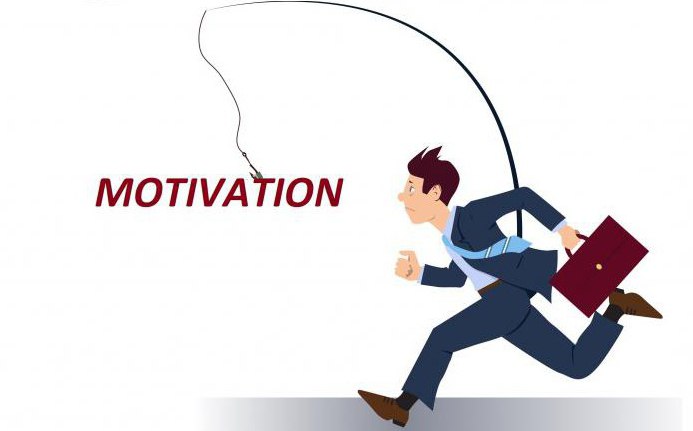Leo Tolstoy said: "Happiness is not always to do what you want, but to always want what you are doing." A system of incentives that encourages a person to do what is needed and get satisfaction from it is called motivation. Motivation is a dynamic process of the physiological nature of a person, which is controlled by the psyche of the individual and manifests itself both at the emotional and behavioral levels. In this article, we will find out what motivation is and how it is formed.

Terminology
So what is motivation? For the first time A. Schopenhauer spoke about motivation. Today, this concept is the subject of research by psychologists, sociologists and educators. Nevertheless, a single definition of motivation still does not exist. There are many hypotheses that, based on scientific research, try to describe the phenomenon of motivation and answer questions:
- Because of what and why a person acts.
- What needs does a person try to satisfy by being active.
- How and why the individual chooses an action strategy.
- What results a person wants to receive and what is their subjective significance for him.
- Why do people with a higher level of motivation than others, ceteris paribus, achieve great success.
In the definition of motivation, scientists are divided into several groups. Representatives of the first of them believe that intrinsic motivation plays a predominant role. By intrinsic motivation is understood as congenital and acquired factors that control human behavior. The second group of scientists considers external factors that affect an individual from the environment to be the main source of motivation. The third is inclined to study the basic motives of the personality and their division into congenital and acquired. The fourth group explores the very essence of motivation as the dominant reason, orienting a person’s behavior towards achieving a specific goal, or as a source of energy necessary for activities that are controlled by other factors, for example, habit.
The majority of scientists consider motivation as a system combining internal factors and external stimuli that determine human behavior. The motivation system consists of the following factors:
- Action vector.
- Purposefulness, consistency, concentration, and organization of actions.
- Activity and assertiveness.
- Sustainability goals.
Motive, goal, need
One of the key concepts of philosophy is such a term as motive. He, like motivation, is understood by scientists in different theories differently. Motive is a conditionally ideal subject, the achievement of which is guided by the activity of the individual. However, he does not have to have a material nature. An individual can perceive a motive in two ways. On the one hand, this is a kind of experience, which can be called a positive anticipation of receiving the subject of needs. And on the other hand, negative emotions arising as a result of dissatisfaction, or partial dissatisfaction with the present state of things. In order to highlight and realize a specific motive, a person must do serious internal work.

In The Theory of Activity, A. Leont'ev and S. Rubinstein gave the most simple concept of motive. According to scientists, the motive is the “objectified” (mentally outlined) need of the individual. At its core, motive is different from concepts such as need and purpose.Need is called the unconscious desire of the subject to get rid of the currently existing discomfort. And the goal is the desired result of conscious targeted action. For example, hunger acts as a natural need, the motive is the desire to eat food, and the goal is a specific dish. Having found out what motivation and motive are, we proceed to consider the types of motivation. In modern psychology, there are quite a few classifications of motivation. We will talk about each of them separately.
Extrusive and intrusive
Extrusive motivation is a set of motives that are caused by the impact on a person of external factors: conditions, circumstances and incentives that are not related to a specific activity. In simple words, this is the external motivation of the activity. Intrinsic motivation, accordingly, has internal reasons that can be determined by a person’s life position: desires, needs, aspirations, interests, drives and attitudes. In the framework of internal motivation, a person acts “voluntarily”, not relying on external circumstances.
The discussion on the appropriateness of such a classification of motivation was highlighted in the works of H. Heckhausen. However, from the perspective of modern psychology, such a discussion is baseless and unpromising. A person, being an active member of society, is not capable in the choice of decisions to be completely independent of the surrounding society.
Positive and negative
Positive motivation is based on expectations and incentives of a positive nature, and negative - respectively, on the contrary. Structures like: “If I take this action, I will receive a reward” and “If I do not perform this action, I will be rewarded” as an example of positive motivation. Examples of negative motivation can be judgments such as: “If I do not do this, they will not punish me” and “If I do this, they will not punish me.” In other words, in the first case, positive reinforcement is expected, and in the second, negative reinforcement.

Steady and unstable
The basis of sustainable motivation is the needs and needs of a person, to satisfy which the individual acts without enlisting additional reinforcement. An example of sustainable motivation can be quenching thirst, warming after hypothermia, and so on. In the case of unstable motivation, a person needs constant stimulation from the outside. Here, as a rule, we are talking about those actions, the failure of which will not become a problem for a person and will leave him at the same level. Volatile motivation may occur when trying to lose weight, quit smoking, and so on. In the theory of motivation, one can often see the separation of stable and unstable motivation into two subspecies. The difference between them is perfectly illustrated by the example: “I want to get rid of extra pounds” or “I want to achieve an attractive figure”.
Additional classification
In addition, motivation is divided into individual, group and cognitive.
Individual motivation expresses a set of needs, incentives and goals aimed at ensuring the normal functioning of the individual and supporting homeostasis. Examples include thirst, hunger, the desire to avoid pain, and so on. Examples of group motivation: maintaining the state system; activities aimed at recognition by society; parental care for children and so on. And finally, cognitive motivation includes scientific activity, the child’s desire to gain knowledge through the game process and so on.
Psychologists, philosophers and sociologists have long tried to classify motives - incentives that potentiate human activity. From the point of view of various motives, scientists have identified the following types of motivation.

Self-affirmation
Self-affirmation is a person’s need for recognition and evaluation by society. The development of motivation in this case is based on self-esteem, self-esteem and ambition. Wishing to assert himself, a person tries to illustrate to others that he is a worthy person. Based on these desires, people strive to obtain a certain status or position, to achieve recognition, respect and respect. In fact, this type of motivation is synonymous with prestige motivation - a thirst to achieve and maintain a high social status in the future. Such a motive as self-affirmation is a very significant factor in motivating the subject's active activity, prompting him to work on himself and personal development.
Identification
We are talking about the desire of the individual to be like an idol. The idol can be either another person (teacher, father, artist), or a fictional character (hero of a movie or book). The motive of identification is a significant incentive for the development of a person and his efforts to acquire certain features. In the juvenile period, the motivation for identifying with an idol is especially strong. Under her influence, teens gain a large supply of energy. The presence of an identification motive is an important factor that leaves the teenager socialized, as it gives inspiration, forms a sense of responsibility and determination.
Power
Expresses a person’s need to influence other people. At certain points in the development of the individual and society as a whole, this motive becomes an essential driving factor. The desire of a person to be a leader in a team, and to occupy leadership positions causes an increase in motivation and the construction of an active action strategy. The desire to dominate is different from the motive of self-affirmation, because in this case a person does not seek to confirm his own importance, but to gain influence on others.
Process-informative
This type of motivation encourages a person to active activity not under the influence of external factors, but because of his personal interest directly in this activity. This is an intrinsic motivation that strongly affects an individual’s activity. The essence of the phenomenon is that a person is interested and enjoys the process itself, exhibiting physical activity and using his intellectual abilities. For example, a girl loves to dance. She enjoys showing her creativity and physical skills. It is motivated by the process itself, and not by external factors, such as popularity, prosperity, etc.

Self development
This type of motivation is based on the individual’s desire to develop existing talents, natural abilities, or qualities. From the point of view of Abraham Maslow, the motivation for self-development forces a person to make every effort to develop his abilities in order to feel competence in a certain field. Self-development allows a person to feel their own significance and needs self-exposure - understanding of the present.
In addition, this type of motivation requires courage, determination and courage to overcome the fear of loss of stability and comfort. People tend to hold on to past achievements and exalt them, which often becomes the main obstacle to further development. Taking the path of self-development, a person prefers to abandon peace in favor of the desire to become better. According to Maslow, self-development is only possible if every step forward brings more satisfaction than past accomplishments. Despite the internal conflict of motives, self-development in its pure form does not need violence against itself.
Progress
This motive implies the desire of the individual to achieve better results in his activities.This motivation is highly effective, since it assumes that the subject consciously chooses more difficult tasks. Motivation for achievement is a driving force for growth in any field of activity, since victory is not only a combination of abilities, skills and natural gift. Success in any undertaking is based on high achievement motivation, which allows a person to show determination, perseverance and determination for the sake of the desired goal.
Prosocial
This is a socially significant type of motivation, based on a sense of personal duty to society or a sense of personal responsibility to a social group. When a person relies on prosocial motivation, he is identified with a particular unit of society. In addition, under the influence of socially significant motives, a person has common interests and goals with this cell.
As a rule, people driven by prosocial motivation have a special inner core and a set of such qualities:
- Regulatory behavior: responsibility, poise, integrity, and constancy.
- Loyal to the standards adopted in the group.
- Recognition and protection of values accepted by the team.
- Sincere desire to achieve the goals of the team.

Affiliation
Such motivation is based on the individual’s desire to establish new contacts and maintain old ones. The essence of the motive is that people highly value communication as an exciting and fun process. Affiliation, in contrast to establishing contacts with selfish goals, satisfies the spiritual needs of people.
Motivation level
Regardless of what type of stimulus a person is moving, his level of motivation can be different. It all depends on the expectations of the person and external circumstances. For example, among scientists, some experts set themselves modest tasks, while others set themselves the hardest. Motivation of activity depends on such factors:
- Significance for a person of the prospects of achieving a goal.
- Belief in achievement.
- Assessment of the probability of success in a particular undertaking.
- Understanding of standards and benchmarks of success.
Methods
To date, various methods of motivation have been successfully applied, which can conditionally be divided into three large groups:
- Social motivation - staff motivation.
- Educational motivation.
- Self motivation.
We will analyze each of their methodologies separately
Social
Social (labor) motivation is a set of measures consisting of moral, material and professional incentives for employees. The purpose of this motivation is to increase the activity, initiative and efficiency of workers. The measures used by management in order to induce vigorous activity of personnel may depend on such factors:
- Incentive system implemented at a specific enterprise.
- Management system in general and personnel management in particular.
- Features of the enterprise: line of business, number of employees, management style, manager experience, etc.

Motivation of employees can be achieved by different methods:
- Economic (material motivation).
- Organizational and administrative. They are based on power (submission to regulations, observance of subordination, etc.) and may involve coercion.
- Socio-psychological. They represent an impact on workers through the activation of their aesthetic beliefs, social interests, religious values and other things.
Training
Motivation for educational activities for students and schoolchildren is the most important link in the educational process. Correctly formed motives and clearly defined goals of the activity make the educational process more meaningful and allow students to achieve better results. In childhood and adolescence, voluntary motivation for learning rarely occurs.Therefore, teachers and psychologists have developed many methods to form a burden of knowledge among students. Educational motivation most often develops using the following methods:
- Creating situations that attract and interest students. It can be fascinating experiences, instructive stories based on life examples, unusual facts and more.
- Comparative analysis of scientific postulates and their everyday interpretation.
- Simulation of scientific disputes, the creation of cognitive debate.
- A joyful experience of achievement and a positive assessment of success.
- Giving facts to novelty.
- Updating training materials.
- The use of positive and negative motivation.
- Social motives.
Self motivation
Self-motivation is called individual methods of motivation, which are based on the internal beliefs of a particular person: aspirations and desires, determination and stability, determination and consistency. When a person continues to go towards his goal, despite impressive external obstacles, this is a manifestation of self-motivation. There are several ways to develop self-motivation:
- Affirmations are specially selected positive statements that have a subconscious effect on a person.
- Self-hypnosis is an independent influence of the personality on the mental sphere, aimed at the formation of new patterns of behavior.
- Studying biographies of prominent personalities. It works on the principle of "If he could, then I can."
- Development of volitional skills.
- Visualization is a mental representation and experience of the results achieved.
Conclusion
Today we have found out what motivation is and what components it consists of. As you can see, motivation is a fairly broad concept, the formation of which occurs under the influence of a number of factors. And everyone needs it, because human nature is structured in such a way that it always rejects development, for the sake of the calm run of life. Therefore, the formation of motivation is worth studying in order to be the master of your body and mind and not stand still.